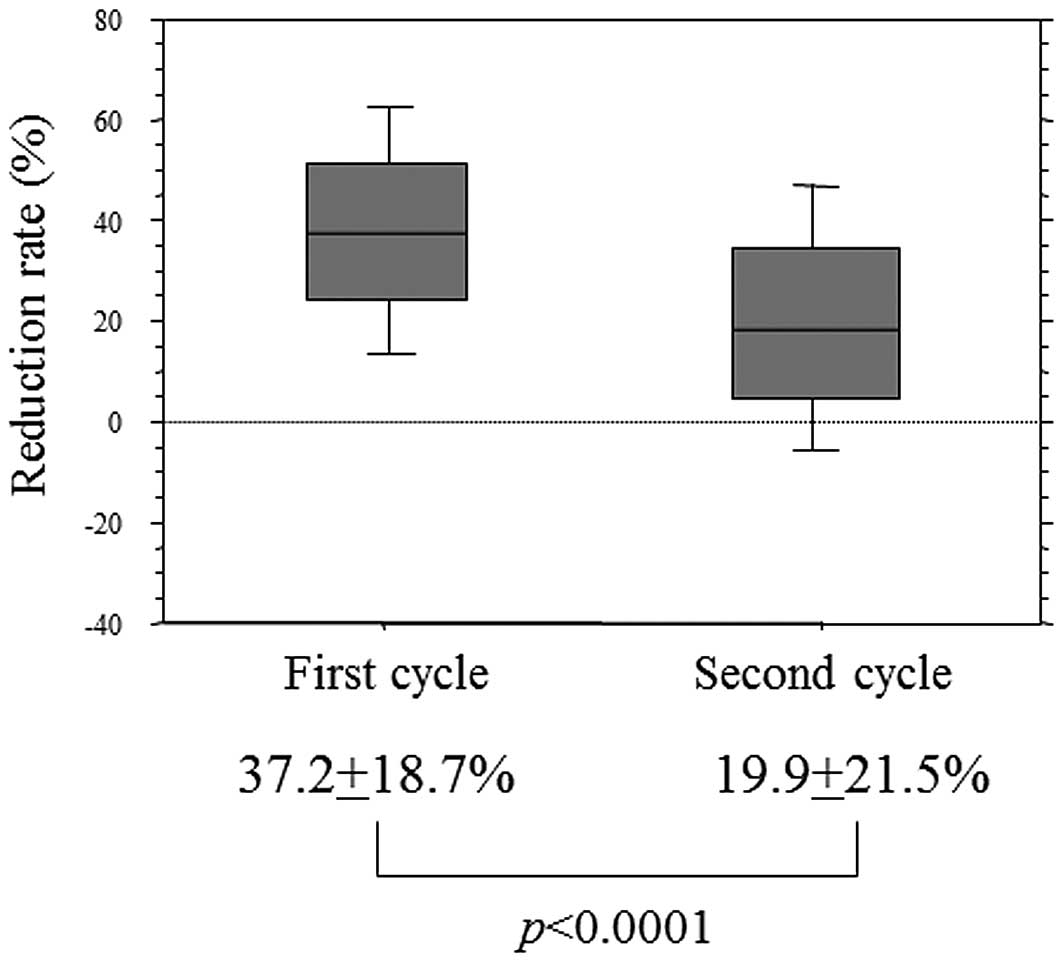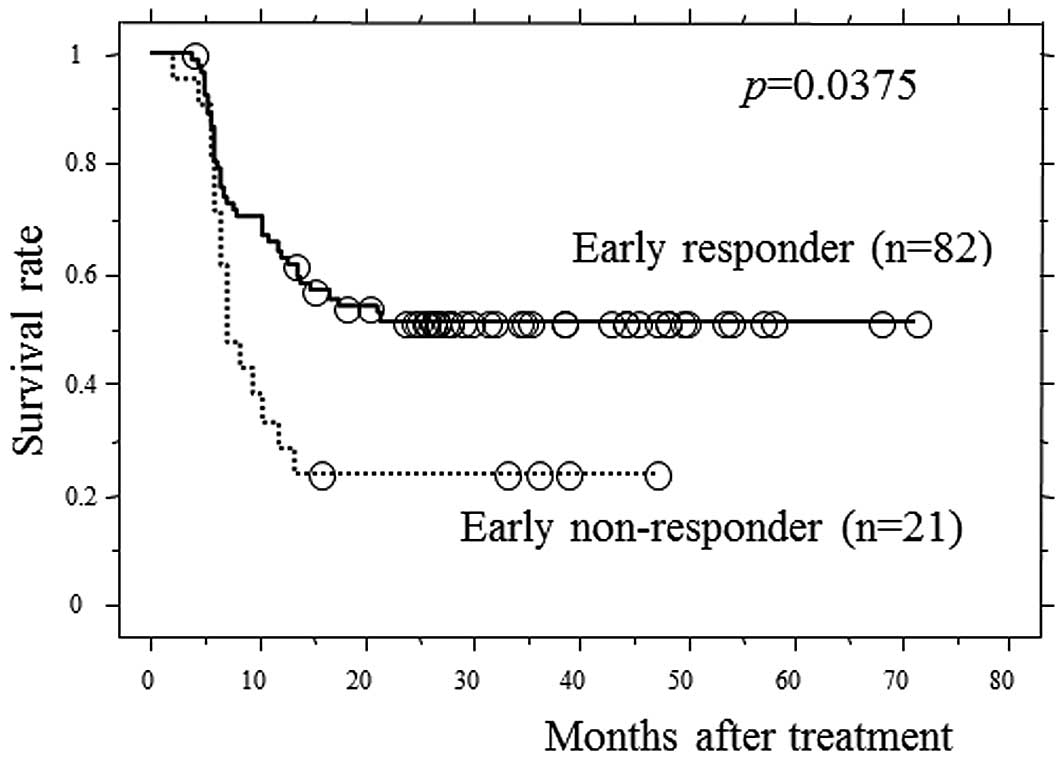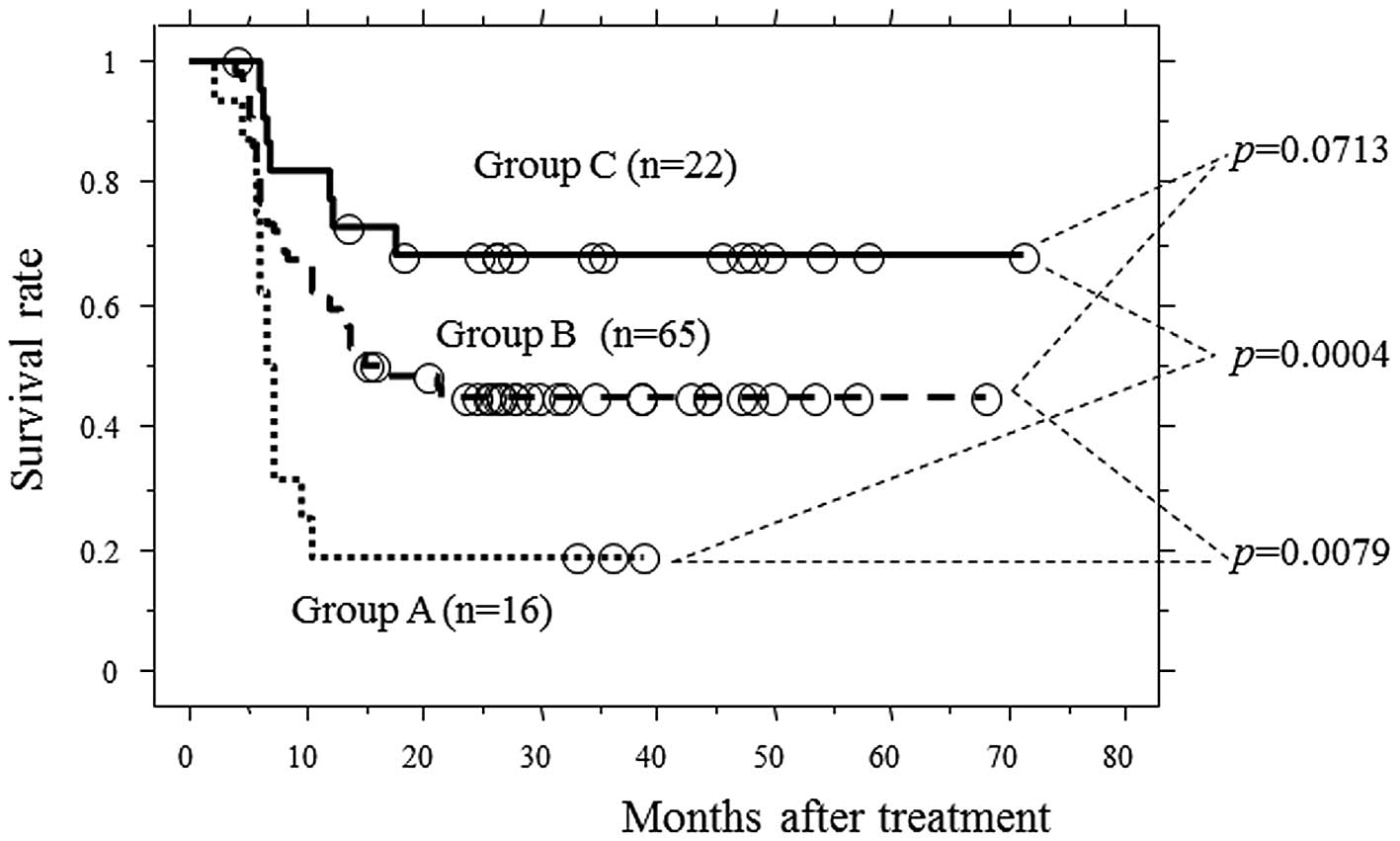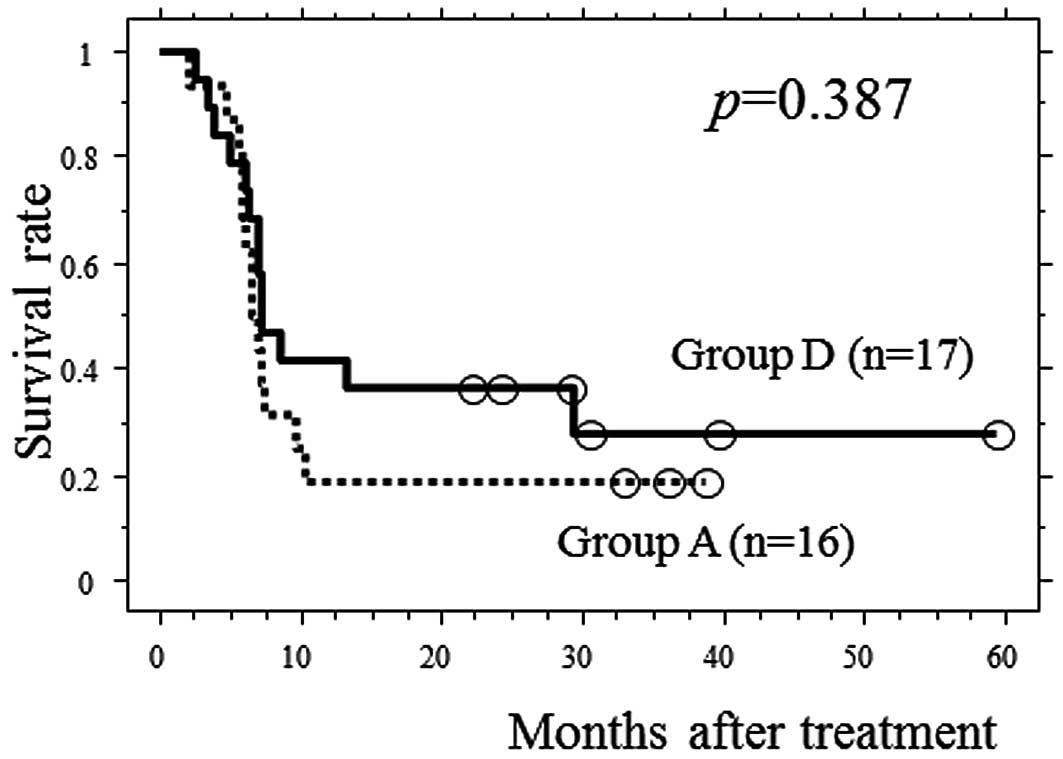Early response to neoadjuvant chemotherapy in advanced esophageal cancer evaluated by computed tomography predicts the utility of a second cycle of chemotherapy
- Authors:
- Published online on: March 11, 2013 https://doi.org/10.3892/mco.2013.89
- Pages: 521-526
Abstract
Introduction
Surgery alone has not been effective in improving the prognosis of advanced esophageal cancer, despite recent advances in surgical techniques and perioperative management. Even following curative resection by esophagectomy with extended 3-field lymphadenectomy, cancer recurs in ∼50% of patients (1). Thus, it is likely that systemic micrometastases are present outside the surgical field at the time of diagnosis. To improve the prognosis of advanced esophageal cancer, neoadjuvant chemotherapy (NACT), administered to eradicate systemic micrometastases, followed by surgical resection, is a promising treatment strategy. Recent studies have reported successful results with NACT (2,3). NACT has been shown to improve the prognosis of responders; however, non-responders suffer from the side effects in addition to losing valuable time seeking alternative treatments (2,4,5). As demonstrated by certain studies, the prognosis of non-responders may be worse than that of patients undergoing primarily surgical treatment (2,4,5). This is partly due to therapy-induced adverse events, selection of chemotherapy-resistant, more biologically aggressive tumors and delay of surgical treatment. Disease progression during ineffective chemotherapy may also be a factor contributing to the poor survival of non-responders. Therefore, prediction of the response to chemotherapy prior to treatment or early during the course of therapy, is critical. Despite intensive efforts to identify predictors of response prior to chemotherapy, there are currently no clear candidate predictors that may be applicable in daily practice (6–8).
In this study, we retrospectively attempted to identify criteria for discontinuing NACT after the first cycle, based on the response as evaluated by computed tomography (CT). Patients with advanced squamous cell carcinoma of the thoracic esophagus received 2 cycles of cisplatin-based chemotherapy as NACT and their response was evaluated by CT following the completion of each cycle.
Materials and methods
Patient eligibility
Between January, 2000 and December, 2008, a total of 988 patients with squamous cell carcinoma of the thoracic esophagus underwent esophagectomy at our hospitals. All patients underwent esophageal fiberscopy and CT scan for tumor staging, according to the 6th edition of the TNM classification (9). Patients satisfying the following criteria were enrolled in this study: i) no prior treatment for esophageal cancer; ii) ≤80 years of age; iii) a performance status (Eastern Cooperative Oncology Group) of 0 or 1; iv) tumor depth of T3 or less; v) no lymph node metastasis or curatively resectable lymph node metastases, including N1 or M1 LYM (cervical or celiac nodes); vi) 2 cycles of NACT comprising 5-fluorouracil (5-FU), adriamycin and cisplatin (FAP therapy) or only 1 cycle of NACT (FAP therapy) due to ineffectiveness; vii) primary tumors that were measurable by CT scan (>10 mm in diameter); viii) adequate organ function (leukocyte count at least in the lower limit of the normal range; platelet count of at least 100,000/mm3; total bilirubin level of ≤2.0 mg/dl; aspartate and alanine aminotransferase levels ≤2.5 times the upper limit of the normal range; and serum creatinine ≤1.5 times the upper limit of the normal range); and ix) CT scans with 5-mm slices prior to NACT and following each cycle of chemotherapy.
The study protocol was approved by the Human Ethics Review Committee of Osaka Medical Center for Cancer and Cardiovascular Diseases, Kinki University and Osaka University Graduate School of Medicine. Written informed consent was obtained from each patient.
Neoadjuvant chemotherapy and evaluation of the response to chemotherapy
The regimen of FAP therapy was as follows: cisplatin at a dose of 70 mg/m2 and adriamycin at a dose of 35 mg/m2 were administered by a drip infusion on day 1. 5-FU was administered at a dose of 700 mg/m2 by continuous infusion on days 1–7. Two cycles of chemotherapy were administered, separated by a 3-week interval (10,11). Patients underwent CT scans with 5-mm slices prior to chemotherapy and 2 weeks after the completion of each cycle. The chemotherapeutic response was evaluated by monitoring the area of the primary tumor. The largest area of the primary tumor was measured bidimensionally, using the greatest diameter and the greatest perpendicular distance. The reduction rate was calculated as: (tumor area prior to treatment - tumor area following treatment)/tumor area prior to treatment. Patients with >50% decrease in the size of the primary tumor after 2 cycles of chemotherapy were defined as responders. Patients with >20% decrease in the size of the primary tumor after the first cycle of chemotherapy were defined as early responders and the remaining patients as early non-responders.
Surgery and pathological findings
Patients were scheduled for surgery ∼4 weeks after the last day of chemotherapy. Surgical therapy consisted of en bloc esophagectomy via right thoracotomy with 2- or 3-field lymphadenectomy and reconstruction using the stomach, jejunum or colon. Pathological T stage was determined according to the TNM classification (9). The pathological response of the primary tumor was defined according to the Japanese Classification of Esophageal Cancer, 10th edition (12) as: grade 3, complete disappearance of cancer cells; grade 2, >2/3 disappearance; grade 1, <2/3 disappearance; grade 0, no therapeutic effect.
Statistical analysis
Statistical analyses were performed using Stat View 5.0J software (SAS Institute, Inc., Cary, NC, USA). Differences in continuous variables were evaluated using the Student’s t-test. The association between two non-continuous parameters was evaluated using the Chi-square test. Univariate and multivariate survival analyses were performed using Cox’s proportional hazards regression model. Survival was calculated by the Kaplan-Meier method and assessed by the log-rank test. A two-tailed p<0.05 was considered to indicate a statistically significant difference.
Results
Patient and tumor characteristics
A total of 103 patients with esophageal cancer received 2 cycles of NACT. The clinical characteristics of these patients are presented in Table I. The majority of the patients were clinically node-positive, since this was used as an indication for NACT. There were 17 patients with clinical stage II disease, 60 with stage III disease and 26 with stage IV disease. The median follow-up period was 25.7 months.
Chemotherapeutic response and reduction rate of the primary tumor in each cycle
Based on a 50% reduction rate as the definition of response, 52 patients were classified as responders and the remaining 51 as non-responders. Responders had a significantly improved progression-free survival (PFS) compared to non-responders (p<0.0001, data not shown). The reduction rate after the first cycle was 37.2±18.7% and that after the second cycle was significantly lower (19.9±21.5%; p<0.0001) (Fig. 1).
Evaluation of early response using CT
To avoid repetition of ineffective therapy, we attempted to establish criteria for discontinuing NACT after the first cycle, based on the response as evaluated by CT. Of the 103 patients, 82 were early responders and 21 were early non-responders, using a 20% decrease in the primary tumor size after the first cycle as the definition of early response. The reduction rate of the second cycle was 23.4±22.0% in early responders and 6.4±12.3% in early non-responders (p=0.001). Fig. 2 shows the PFS curves according to early response status. The 3-year PFS rate of early responders and early non-responders was 53.2 and 22.2%, respectively, and early responders exhibited significantly higher survival rates, compared to early non-responders (p=0.0375). Table II lists the baseline and pathological characteristics of early responders vs. early non-responders. Females had a higher early response rate compared to males (p=0.0011). Early responders had a more favorable pathological T stage, pathological tumor response and number of metastatic lymph nodes, compared to early nonresponders (p=0.023, 0.009 and 0.041, respectively).
Prognostic significance of early response
Among the clinical characteristics available prior to the initiation of the second cycle of chemotherapy, including gender (male/female), age (<70/>70 years), tumor location (upper/middle, lower esophagus), T stage (T1–2/T3), N stage (N0-1/M1 LYM) and early response status (early responder/early non-responder), T1-2 and early responder status were significantly correlated with higher PFS rates in a univariate analysis (p=0.031 and 0.032, respectively; Table III). A multivariate analysis using T stage and early responder status demonstrated that the two factors were independently associated with PFS (p=0.028 and 0.0062, respectively; Table III). PFS curves among patients with both unfavorable factors (group A; T3 and early non-responders), those with no unfavorable factors (group C; T1-2 and early responders) and the remaining patients (group B; others) were examined. Group A had a significantly worse PFS when compared to groups B and C (p=0.0079 and 0.0004, respectively; Fig. 3) .
Significance of the second cycle of chemotherapy in group A patients
Twenty-five patients discontinued NACT after the first cycle due to ineffectiveness and underwent esophagectomy. Among these patients, 17 had clinical T3 tumors and exhibited <20% decrease in the size of the primary tumor following the first cycle of NACT (group D). To investigate the significance of the second cycle of chemotherapy in group A patients, we compared PFS between group A and group D patients. No significant differences in the baseline clinical factors and the reduction rate after the first cycle of chemotherapy between the 2 groups were observed (Table IV). No significant difference were identified in PFS between the 2 groups (Fig. 4).
Discussion
Multiple cycles of cisplatin-based chemotherapy is a standard protocol for NACT for advanced esophageal cancer. In order to avoid the repetition of ineffective therapy in non-responders, it is important to establish criteria for discontinuing NACT after the first cycle. In early non-responders (patients with <20% decrease in the size of the primary tumor after the first cycle of chemotherapy), the reduction rate after the second cycle of chemotherapy, PFS and pathological factors (pathological T stage, pathological response of the primary tumor and number of metastatic lymph nodes) were significantly worse. Therefore, evaluation of early response with CT may be a useful method for identifying patients likely to have unfavorable outcomes after a number of courses of NACT. Among the clinical variables available prior to administration of the second cycle of NACT, clinical T3 stage and early non-responder status were independent unfavorable prognostic factors, and patients with the two factors exhibited significantly poorer PFS. Moreover, there was no significant difference between the prognosis of patients who had both unfavorable factors and received 1 or 2 cycles of NACT. Therefore, in patients with both unfavorable prognostic factors, the second cycle of NACT should be avoided, and patients should undergo salvage therapies, such as alternative chemotherapy regimens, chemoradiotherapy, or immediate surgery. Such an individualized approach may improve prognosis by reducing the length of time during which a patient receives ineffective therapy.
Previous studies have demonstrated that metabolic response as measured by positron emission tomography (PET) may help differentiate between responding and non-responding esophageal cancers early in the course of therapy (13–15). Weber et al(15) reported that changes in tumor metabolic activity after 14 days of NACT, as assessed using PET, were significantly correlated with histopathological response and survival rates. However, CT is more prevalent and PET is associated with issues regarding the complexity of the technology and the absence of standardization for metabolic imaging.
Among baseline factors, clinical T stage was significantly correlated with prognosis, as opposed to clinical N stage. Clinical T stage was significantly correlated with pathological T stage (p=0.0001). There was no correlation between clinical N stage and the number of metastatic lymph nodes. This may be partly attributed to the fact that we administered NACT mainly to clinically node-positive esophageal cancer patients. The rate of early response was significantly higher in females compared to males. Overall response (after the second cycle of NACT) was also significantly higher in females (p=0.0011, data not shown). The response to chemotherapeutic agents may be partly determined by drug concentration in the tumor environment (16,17). Investigators have previously suggested that gender-specific pharmacokinetics exist for certain chemotherapeutic agents. Milano et al(18) reported that the capacity to clear 5-FU is lower in women than in men. Dobbs et al(19) demonstrated that, among patients with normal liver function, men exhibit a higher rate of doxorubicin clearance compared to women. Higher response to chemotherapy in females observed in this study may partly be due to the higher blood concentrations of chemotherapeutic agents.
The reduction rate after the second cycle was significantly worse compared to that after the first cycle. This was consistent with a previous study (20). It is likely that tumors are heterogeneous and the first cycle eliminates only the sensitive tumor cells, sparing resistant tumor cells (21). Another reason is that the first cycle may eliminate tumor cells located around the tumor vessels with a high drug concentration and the second cycle may kill tumors distant from the tumor vessel with a low drug concentration. The efficacy of chemotherapy may deteriorate as the number of cycles increases. When administering multiple cycles of NACT, physicians should evaluate chemotherapeutic response following completion of each cycle of chemotherapy.
Early non-responders were defined as the patients with <20% decrease in the size of the primary tumor after the first cycle of chemotherapy. When the cut-off value was set at 30%, the reduction rate after the second cycle chemotherapy, PFS, pathological T stage and pathological response were significantly worse in early non-responders, although there was no significant difference in the number of metastatic lymph nodes between the 2 groups. When the cut-off value was set at 10%, there was no significant difference in PFS between the 2 groups. The relatively low threshold of 20% may be appropriate, since it ensures that all patients who potentially benefit from NACT receive further treatment.
In conclusion, this study has demonstrated that the reduction rate of the primary tumor as evaluated by CT after the first cycle of NACT may aid physicians in determining whether to administer the second cycle. In patients with T3 tumors and <20% decrease in the size of the primary tumor after the first cycle of chemotherapy, NACT should be discontinued after the first cycle.
References
|
Akiyama H, Tsurumaru M, Udagawa H and Kajiyama Y: Radical lymph node dissection for cancer of the thoracic esophagus. Ann Surg. 220:364–372. 1994. View Article : Google Scholar : PubMed/NCBI | |
|
Medical Research Council Oesophageal Cancer Working Group: Surgical resection with or without preoperative chemotherapy in oesophageal cancer: a randomised controlled trial. Lancet. 359:1727–1733. 2002. View Article : Google Scholar : PubMed/NCBI | |
|
Ando N, Kato H, Igaki H, et al: A randomized trial comparing postoperative adjuvant chemotherapy with cisplatin and 5-fluorouracil versus preoperative chemotherapy for localized advanced squamous cell carcinoma of the thoracic esophagus (JCOG9907). Ann Surg Oncol. 19:1968–1974. 2012. View Article : Google Scholar | |
|
Kelsen DP, Ginsberg R, Pajak TF, et al: Chemotherapy followed by surgery compared with surgery alone for localized esophageal cancer. N Engl J Med. 339:1979–1984. 1998. View Article : Google Scholar : PubMed/NCBI | |
|
Yano M, Takachi K, Doki Y, et al: Preoperative chemotherapy for clinically node-positive patients with squamous cell carcinoma of the esophagus. Dis Esophagus. 19:158–163. 2006. View Article : Google Scholar : PubMed/NCBI | |
|
Kishi K, Doki Y, Yano M, et al: Reduced MLH1 expression after chemotherapy is an indicator for poor prognosis in esophageal cancers. Clin Cancer Res. 9:4368–4375. 2003.PubMed/NCBI | |
|
Motoori M, Takemasa I, Yamasaki M, et al: Prediction of the response to chemotherapy in advanced esophageal cancer by gene expression profiling of biopsy samples. Int J Oncol. 37:1113–1120. 2010.PubMed/NCBI | |
|
Luthra R, Wu TT, Luthra MG, et al: Gene expression profiling of localized esophageal carcinomas: association with pathologic response to preoperative chemoradiation. J Clin Oncol. 24:259–267. 2006. View Article : Google Scholar | |
|
Sobin LH and Wittekind CH: TNM Classification of Malignant Tumors. 6th edition. Wiley-Liss; New York, NY: 2002 | |
|
Motoori M, Yano M, Yasuda T, et al: Chemotherapy-induced toxicities and treatment efficacy in advanced esophageal cancer treated with neoadjuvant chemotherapy followed by surgery. Esophagus. 8:81–87. 2011. View Article : Google Scholar | |
|
Matsuyama J, Doki Y, Yasuda T, et al: The effect of neoadjuvant chemotherapy on lymph node micrometastases in squamous cell carcinomas of the thoracic esophagus. Surgery. 141:570–580. 2007. View Article : Google Scholar : PubMed/NCBI | |
|
Japanese Society for Esophageal Diseases: Guidelines for the Clinical and Pathologic Studies on Carcinoma of the Esophagus. 10th edition. Kanehara Syuppan; Tokyo: 2007 | |
|
Wieder HA, Brücher BL, Zimmermann F, et al: Time course of tumor metabolic activity during chemoradiotherapy of esophageal squamous cell carcinoma and response to treatment. J Clin Oncol. 22:900–908. 2004. View Article : Google Scholar : PubMed/NCBI | |
|
Lordick F, Ott K, Krause BJ, et al: PET to assess early metabolic response and to guide treatment of adenocarcinoma of the oesophagogastric junction: the MUNICON phase II trial. Lancet Oncol. 8:797–805. 2007. View Article : Google Scholar : PubMed/NCBI | |
|
Weber WA, Ott K, Becker K, et al: Prediction of response to preoperative chemotherapy in adenocarcinomas of the esophagogastric junction by metabolic imaging. J Clin Oncol. 19:3058–3065. 2001.PubMed/NCBI | |
|
Gamelin EC, Danquechin-Dorval EM, et al: Relationship between 5-fluorouracil (5-FU) dose intensity and therapeutic response in patients with advanced colorectal cancer receiving infusional therapy containing 5-FU. Cancer. 77:441–451. 1996. View Article : Google Scholar | |
|
Di Paolo A, Lencioni M, Amatori F, et al: 5-fluorouracil pharmacokinetics predicts disease-free survival in patients administered adjuvant chemotherapy for colorectal cancer. Clin Cancer Res. 14:2749–2755. 2008.PubMed/NCBI | |
|
Milano G, Etienne MC, Cassuto-Viguier E, et al: Influence of sex and age on fluorouracil clearance. J Clin Oncol. 10:1171–1175. 1992.PubMed/NCBI | |
|
Dobbs NA, Twelves CJ, Gillies H, et al: Gender affects doxorubicin pharmacokinetics in patients with normal liver biochemistry. Cancer Chemother Pharmacol. 36:473–476. 1995. View Article : Google Scholar : PubMed/NCBI | |
|
Akita H, Doki Y, Miyata H, et al: Clinical significance of the second cycle response to cisplatin-based chemotherapy as preoperative treatment for esophageal squamous cell carcinoma. J Surg Oncol. 93:401–409. 2006. View Article : Google Scholar : PubMed/NCBI | |
|
Mathieu A, Remmelink M, D’Haene N, et al: Development of a chemoresistant orthotopic human nonsmall cell lung carcinoma model in nude mice: analyses of tumor heterogenity in relation to the immunohistochemical levels of expression of cyclooxygenase-2, ornithine decarboxylase, lung-related resistance protein, prostaglandin E synthetase, and glutathione-S-transferase-alpha (GST)-alpha, GST-mu, and GST-pi. Cancer. 101:1908–1918. 2004. |













